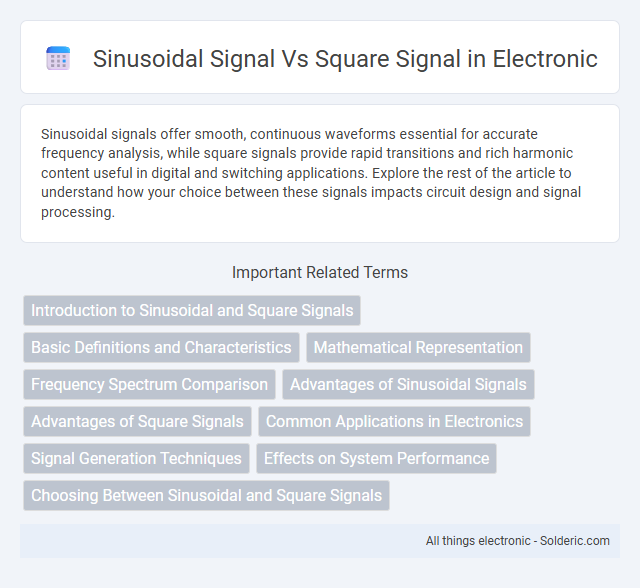Sinusoidal signals offer smooth, continuous waveforms essential for accurate frequency analysis, while square signals provide rapid transitions and rich harmonic content useful in digital and switching applications. Explore the rest of the article to understand how your choice between these signals impacts circuit design and signal processing.
Comparison Table
| Feature | Sinusoidal Signal | Square Signal |
|---|---|---|
| Waveform Shape | Smooth, continuous oscillation | Alternates between two levels; abrupt transitions |
| Frequency Spectrum | Single fundamental frequency | Fundamental plus odd harmonics |
| Applications | AC power, communication carriers | Digital signals, clock pulses |
| Harmonics | Minimal, pure tone | Strong higher-order harmonics |
| Energy Efficiency | Efficient in frequency domain | Less efficient due to harmonic content |
| Signal Smoothness | Continuous and smooth | Discontinuous, sharp edges |
Introduction to Sinusoidal and Square Signals
Sinusoidal signals exhibit smooth, continuous waveforms characterized by a single frequency, making them fundamental in analyzing linear time-invariant systems and essential in analog communication. Square signals, defined by abrupt transitions between high and low levels, contain a rich harmonic spectrum, leading to applications in digital electronics and switching circuits. Understanding the distinct frequency components and time-domain behaviors of these signals enables you to optimize signal processing and system design effectively.
Basic Definitions and Characteristics
A sinusoidal signal is a continuous waveform characterized by smooth, periodic oscillations defined by amplitude, frequency, and phase, commonly represented as a sine or cosine function. A square signal alternates between two discrete amplitude levels with abrupt transitions, exhibiting a 50% duty cycle in its most basic form. Unlike sinusoidal signals that contain a single frequency component, square signals comprise a fundamental frequency and multiple odd harmonics, affecting their spectral content and applications in digital electronics and signal processing.
Mathematical Representation
A sinusoidal signal is mathematically represented by a continuous function such as \( x(t) = A \sin(2\pi f t + \phi) \), where \( A \) is amplitude, \( f \) is frequency, \( t \) is time, and \( \phi \) is phase. A square signal, on the other hand, can be expressed as a Fourier series summation of odd harmonics: \( x(t) = \frac{4A}{\pi} \sum_{n=1,3,5...}^{\infty} \frac{1}{n} \sin(2\pi n f t) \). Understanding these mathematical representations helps you analyze signal characteristics such as bandwidth and harmonic content.
Frequency Spectrum Comparison
Sinusoidal signals exhibit a frequency spectrum concentrated at a single fundamental frequency, making them ideal for applications requiring pure tones and minimal harmonic distortion. Square signals, however, contain an infinite series of odd harmonics, resulting in a rich frequency spectrum that can cause more electromagnetic interference but is useful in digital switching and clock signals. Understanding this contrast allows you to select the appropriate signal type based on spectral purity or harmonic content for your specific frequency domain requirements.
Advantages of Sinusoidal Signals
Sinusoidal signals offer smooth periodic waveforms characterized by a single frequency component, leading to minimal harmonic distortion and reduced electromagnetic interference compared to square signals. Their continuous and differentiable nature allows for efficient analysis using Fourier transforms, making them ideal for communication systems and signal processing applications. When your system requires predictable frequency behavior and reduced noise, sinusoidal signals provide superior performance and reliability.
Advantages of Square Signals
Square signals offer clear advantages in digital communication and switching circuits due to their rapid transitions between high and low states, enabling accurate timing and synchronization. Their harmonic-rich spectrum allows efficient representation of binary data, facilitating easy detection and processing by digital devices. You benefit from enhanced noise immunity and simpler waveform generation compared to sinusoidal signals.
Common Applications in Electronics
Sinusoidal signals are fundamental in AC power systems, audio signal processing, and communication systems due to their smooth periodic oscillations, which minimize harmonic distortion. Square signals are widely used in digital electronics, clock generation, and switching circuits because their sharp transitions enable precise timing and efficient signal representation. Understanding the characteristics of these signals helps optimize Your electronic design for specific applications such as filtering, modulation, or timing control.
Signal Generation Techniques
Sinusoidal signals are primarily generated using oscillators such as Wien bridge or crystal oscillators, which provide smooth periodic waveforms essential for analog communication and signal processing. Square signals are typically created through digital circuits like flip-flops, multivibrators, or microcontroller timers, offering rapid transitions between high and low states ideal for clocking and switching applications. Efficient signal generation depends on the desired frequency stability, harmonic content, and application-specific requirements in communication and control systems.
Effects on System Performance
Sinusoidal signals provide smooth and continuous waveforms that minimize energy loss and reduce electromagnetic interference, enhancing system efficiency and stability. Square signals, characterized by abrupt transitions and high-frequency harmonics, can introduce signal distortion and increased electromagnetic interference, potentially degrading system reliability and causing unwanted noise. Systems designed for precise control or communication often perform better with sinusoidal signals due to their minimal harmonic content and improved signal integrity.
Choosing Between Sinusoidal and Square Signals
Choosing between sinusoidal and square signals depends heavily on the application requirements such as harmonic content and system response. Sinusoidal signals offer smooth, single-frequency waveforms ideal for minimizing electromagnetic interference and reducing distortion in analog circuits. Square signals provide rapid transitions with rich harmonic content, making them suitable for digital timing and switching applications where sharp, precise signal changes are crucial.
sinusoidal signal vs square signal Infographic

 solderic.com
solderic.com